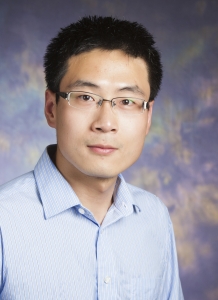

Dr. Bo Zhao is a recent graduate from the University of Illinois at Urbana-Champaign where he earned his PhD in electrical and computer engineering. Dr. Zhao is currently a research fellow at the MGH/HST Martinos Centre for Biomedical Imaging at Harvard Medical School. His paper entitled “Accelerated parameter mapping with low-rank and sparsity constraints” was an Editor’s pick for the month of August. We contacted Bo and senior author Dr. Zhi-Pei Liang to discuss their research and the details of the featured paper.
MRMH: Can you tell us in plain language the main points of your paper?
Bo: The paper reports a model-based approach for accelerated MR parameter mapping. The model integrates two mathematical constraints known in signal processing as sparsity and low rank structure. As you may know, sparsity constraint is a key element of the popular compressed sensing theory, which enables recovery of signals from sub-Nyquist measurements; complementary to the sparsity constraint, the low-rank constraint provides another mathematical structure to achieve sub-Nyquist sampling. Dr. Liang’s group has been working on low-rank model-based imaging for many years. The key novelty of this paper lies in utilizing both sparsity and low-rank constraints to design data acquisition and image reconstruction for accelerated MR parameter mapping with sparse sampling. .
Zhi-Pei: A major challenge in parameter mapping is long data acquisition times. Conventional parameter mapping acquires several images with slightly different acquisition parameters, so there is a lot of redundant information collected. Bo’s approach reduces the redundancy in data acquisition, thus the acceleration.
MRMH: How does your method compare against existing fast relaxometry techniques?
Bo: Our method could be used to speed up any MRI application where parameter mapping is used for tissue characterization. In particular, it provides a novel modeling framework to parsimoniously represent MR relaxometry data. Within this framework, a whole bunch of approaches can be explored, such as simultaneous multi-slice parameter mapping, 3D imaging, and MR Fingerprinting.
Zhi-Pei: All those techniques for accelerated parameter mapping are very much complementary at this stage. For example, the famous and powerful MR Fingerprinting technique Bo mentioned uses stronger prior information about tissue parameter distribution to enable ultrafast parameter mapping, but it doesn’t preclude the use of sparsity and low-rank constraints for further speed enhancement. Such an integration would be particularly useful for 3D parameter mapping, although computational time could be a concern.
MRMH: Dr. Zhao, how did you get into MRI?
Bo: After I joined the University of Illinois for my Ph.D. study, I had a chance to take Dr. Liang’s class on MRI. I found that MRI is a fascinating imaging modality, not only because of its tremendous power and potential, but also because of its strong connection to physics and engineering, especially signal processing. So, I decided to pursue my Ph.D. thesis research in this area.
MRMH: How about you Dr. Liang, what is your MRI origins story?
Zhi-Pei: It was pure luck for me. When I was a graduate student at Case Western Reserve University, I attended a public lecture by Dr. Paul Lauterbur, during a ceremony honoring him for his pioneering work on MRI; I immediately fell in love with the field. After my graduation, I joined the University of Illinois, where I had the privilege of working with Dr. Lauterbur for another 17 years before he passed away in 2007.
MRMH: What do you do outside the lab?
Bo: Urbana is a quiet campus, which really lets you focus on your research. Boston, on the other hand, is a fascinating city, with lots of sports, museums… Since I moved there, I have managed to spend some time to explore the city over the weekends.
Zhi-Pei: Bo gave you a hint already; Urbana is in the middle of a cornfield, so what can you do other than manipulating spins? (Laughs) As a father and husband, I enjoy spending as much time as I could with my family; being Chinese, I also like playing table tennis. I walk about 1.5 miles every early morning, which is fun, especially so in the snowy winters here!
MRMH: You mentioned your Chinese heritage, are you involved in MRI outreach efforts there?
Zhi-Pei: As much as I could; but given my limited ability and charm, I haven’t received any call from the ISMRM office about it yet. (Laughs) I did help set up the Paul Lauterbur Research Center for Biomedical Imaging under the Chinese Academy of Sciences. That Institute has really exploded over the last 6-7 years. I expect great work to come out of those talented young people in the coming years.
MRMH: What are your plans for the future and where do you see the field of quantitative MRI going?
Bo: I think a key challenge in quantitative MRI is to relate the measured MR parameters to true tissue biophysical properties or microstructure. To establish such a correlation, we need to further improve our understanding and modeling of the underlying physical and physiological processes; we also need to improve our technology to better compensate for imperfections from hardware and pulse sequences. Regarding my future plans, I would like to pursue an academic career to push the boundary of MRI technology, especially for quantitative neuroimaging.
Zhi-Pei: Bo is very, very talented, and I am sure he will have a successful career in academia. Talking about quantitative imaging, one exciting area is accelerated high-resolution spectroscopic imaging, which would give us important physiological information of tissues beyond T1 and T2 values without using exogenous molecular reporters.
MRMH: What advice would you give to young MRI researchers?
Bo: Get good training in physics and signal processing!
Zhi-Pei: Aim high, dream big. God gives us 3 things at a fundamental level: mass, charge, and spin. There is still a lot of exciting work that can be done in using spins to unravel the mystery of biology and revolutionize healthcare. Go “spin”!
* Karolina Urban and Nikola Stikov contributed to this Q&A
